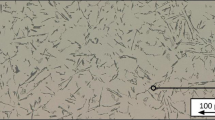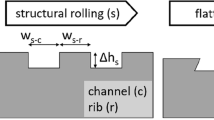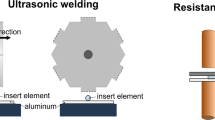Abstract
For structural components in the vehicle body, a trend can be observed where components such as suspension struts or side members in differential steel design are being replaced by an integral design made of cast aluminum. The advantages here are a reduction in the number of individual parts and weight savings. However, since the rest of the body is still made of steel, the integration of cast parts presents the challenge of joining these dissimilar materials in the body shop. Due to the different chemical and physical properties of cast aluminum and steel, cold hybrid joining technologies such as self-pierce riveting in combination with gluing are largely used for this purpose. However, these technologies are associated with higher cycle times and larger space requirements than conventional spot welding for steel joints. In order to meet these challenges and to optimize the integration of castings into steel bodies, this thesis is looking into the possibility of producing hybrid Al/steel assemblies in foundries where the attachment points to the body are made of steel. These can then be integrated in the body shop using conventional spot welding. To produce these Al/steel assemblies, a hybrid joining method consisting of compound casting and friction stir welding was developed and investigated with the aim of meeting both the mechanical requirements of the body and the production sequences of the foundry. In order to gain an understanding of the joining mechanisms, the processes were first investigated separately and then combined with the aim of obtaining an overall higher joint strength. To this end, a sample geometry and test setup were designed to produce compound samples with different specifications of the steel insert using the high pressure die casting process. In a subsequent process step, the compound casting area was friction stir welded to achieve the final joint strength. Characterization of the joint properties was carried out by tensile tests and damage patterns as well as via microstructure analyses.














Similar content being viewed by others
References
Friedrich H, Krishnamoorthy S, Friedrich H (2017) Springer Fachmedien Wiesbaden, Germany, 16–20
Kleemann S, Türck E, Vietor T (2016) Towards knowledge based engineering for multi-material design. Int Des Conf - Des. https://doi.org/10.24355/dbbs.084-201704031138
Goede M et al (2011) Demands of electromobility on future car body lightweight design. In: Materials in Car Body Engineering, Bad Nauheim
Heinrich S (2013) Auftrieb für Strukturbauteile. Giesserei 101:180–183
Dehghani M, Amadeh A, Akbari Mousavi SAA (2013) Investigations on the effects of friction stir welding parameters on intermetallic and defect formation in joining aluminum alloy to mild steel. Mater Design 49:433–441
Teichmann F, Müller S, Dilger K (2018) “Investigations on dual laser beam welding of aluminum high pressure die castings at reduced ambient pressure”. J Laser Appl 30:032420. https://doi.org/10.2351/1.5040640
Tomazic D et al (2013) Handlungsfeld Trenn- und Hilfsstoffe im Druckgießprozess. Energie- und ressourceneffiziente Produktion von Aluminiumdruck-guss. Springer Vieweg, Berlin, Heidelberg, pp 185–187. https://doi.org/10.1007/978-3-642-39853-7_7
Meschut G, Janzen V, Olfermann T (2014) Innovative and highly productive joining Technologies for Multi-Material Lightweight Car body structures. J Mater Eng Perform 23:1515–1523. https://doi.org/10.1007/s11665-014-0962-3
Haghshenas M, Gerlich AP (2018) Joining of auto-motive sheet materials by friction-based welding methods: a review. Eng Sci Technol Int J 21:130–148. https://doi.org/10.1016/j.jestch.2018.02.008
Krutzlinger M, Marstatt R, Suenge S, Luderschmid J, Zaeh MF, Haider F (2014) Formation of joining mechanisms in friction stir welded dissimilar Al-Ti lap joints. Adv Mater Res 966–967:510–520. https://doi.org/10.4028/www.scientific.net/AMR.966-967.510
Marstatt R, Krutzlinger M, Luderschmid J, Zaeh MF, Haider F (2017) Formation of a diffusion-based intermetallic interface layer in friction stir welded dissimilar Al-Cu lap joints. IOP Conf Ser: Mate Sci Eng. https://doi.org/10.1088/1757-899X/181/1/012002
Merklein M, Giera A, Geiger M (2005) Deep drawing of friction stir welded thin sheet aluminium-steel tailored hybrids. Steel Res Int 76:250–256. https://doi.org/10.1002/srin.200506005
Schmid D (2014) Rührreibschweißen von Aluminiumlegierungen mit Stählen für die Automobilindustrie. Forschungsberichte IWB, Band 297, PhD. Thesis
Chen YC, Komazaki T, Tsumura T, Nakata K (2008) Role of zinc coat in friction stir lap welding Al and zinc coated steel. Mater Sci Technol 24:33–39. https://doi.org/10.1179/174328407X248505
Chen YC, Komazaki T, Kim YG, Tsumura T, Nakata K (2008) Interface microstructure study of friction stir lap joint of AC4C cast aluminum alloy and zinc-coated steel. Mater Chem Phys 111:375–380. https://doi.org/10.1016/j.matchemphys.2008.04.038
Kusuda Y (2013) Honda develops robotized FSW technology to weld steel and aluminum and applied it to a mass-production vehicle. Industrial Robot 40:208–212. https://doi.org/10.1108/01439911311309889
Coelho R, Kostka A, Sheikhi S, dos Santos J, Kaysser-Pyzalla A (2008) Microstructure and mechanical properties of an AA6181-T4 aluminium alloy to HC340LA high strength steel friction stir overlap weld. Adv Eng Mater 10:961–972. https://doi.org/10.1002/adem.200800028
Zäh MF, Ruhstorfer M, Gebhard P (2008) Aktuelle Forschungstrends in der Produkt- und Prozess-gestaltung. Maschinenbau 36:42–45
Ruhstorfer M (2012) Rührreibschweißen von Rohren. Forschungsberichte IWB, Band 262, PhD. Thesis
Geiger M, Merklein M, Giera A, Staud D (2006) Experimental and analytical investigations on friction stir welding of steel aluminium tailored hybrids. Prod Eng Annals German Acad Soc Prod Eng 8:81–86
Sorger G, Wang H, Vilaça P, Santos T (2017) FSW of aluminum AA5754 to steel DX54 with innovative overlap joint. Weld World 61:257–268. https://doi.org/10.1007/s40194-016-0412-y
Das H, Basak S, Das G, Pal T (2012) Influence of energy induced from processing parameters on the mechanical properties of friction stir welded lap joint of aluminum to coated steel sheet. Int J Adv Manuf Technol 64:1653–1661. https://doi.org/10.1007/s00170-012-4130-3
Greß T (2021) Vertical Continuous Compound Casting of Copper Aluminium Semi-Finished Products - Design of a Resource-Efficient Production Technology for the Formation of Metallurgically Bonded Bilayer Parts, PhD. Thesis, Technische Universität München, Lehrstuhl für Umformtechnik und Gießereiweisen 9–10
Burbach T (2013) Verbundguss und gegossene Verbundwerkstoffe. In: Bührig-Polaczek A, Michaeli W (eds) Spur G Handbuch Urformen. Carl Hanser Verlag GmbH & Co. KG, München
Schwankl M, Wedler J, Körner C (2016) Wrought Al - cast Al compound casting based on zincate treatment for aluminum wrought alloy inserts. J Mater Process Technol 238:160–168
Clausen J, Kelch M, Wöstmann FJ, Busse M (2018) Mechanical characterization of integral aluminum-FRP-structures produced by high pressure die-casting. Prod Eng Res Devel 12:269–278
Schittenhelm D, Ségaud J-M (2018) Steel reinforced Al die casting. 3rd international VDI congress, casting chassis and bodywork components
Bührig-polaczek A, Röth T, Baumeister E, et al. (2006) Hybride Leichtbaustrukturen in Stahlblech-Leichtmetall Verbundguss. Internationaler Expertenpreis Automobilleichtbau, 15. Europäische Automobil-Leichtbaukonferenz,
Lao B, Bührig-polaczek A (2011) Metal hybrid composite casting. Patent publication number: WO2011131712A1
Schittenhelm D (2018) Topologieoptimierter Verbund von Aluminium und Stahl zur lokalen Steifigkeitserhöhung von Druckgussbauteilen. PhD, Thesis
Fang XF (2017) Evaluation of coating systems for steel aluminum hybrid casting. J Mater Sci Eng 3–4:51–67. DOI: https://doi.org/10.17265/2161-6213/2017.3-4.001
Rheinfelden alloys (2015) Alloys for Pressure Die Casting https://rheinfelden-alloys.eu/wp-content/uploads/%202016/01/05-HB-DG_Ci_Sf_Cm_Td_Ma_RHEINFELDEN-ALLOYS_2015_EN.pdf
Richter F (2015) The Physical Properties of Steels „The 100 Steels Programme “Part I: Tables and Figures. https://www.tugraz.at/fileadmin/user_upload/Institute/IEP/Thermophysics_Group/Files/Staehle-Richter.pdf
Cespedes-Gonzales GE (2012) Aluminium-Stahl-Verbund-Guss als strukturgebendes Fügeverfahren für attraktive Fahrwerkskomponenten – Darlegung der Prozesskette. PhD. Thesis, Technische Universität Bergakademie Freiberg
Sadowski T, Balawender T (2010) Technology of clinch–adhesive joints. In: da Pirondi SL, Öchsner A, A. (eds) Hybrid adhesive joints. Advanced Structured materials, vol 6. Springer, Berlin, Heidelberg. https://doi.org/10.1007/8611_2010_45
Yuan W, Jordon B, Ghaffari B, Rao H et al (2017) “Mechanical performance of friction stir linear welds of Al to mg alloys.” SAE Tech Pap. https://doi.org/10.4271/2017-01-0467
Her S-C, Chan C-F (2019) Interfacial stress analysis of adhesively bonded lap joint. Materials 12:2403. https://doi.org/10.3390/ma12152403
da Silva LFM, Marques EAS, Campilho RDSG (2018) Design rules and methods to improve Joint Strength. In: da Silva L, Öchsner A, Adams R (eds) Handbook of Adhesion Technology. Springer, Cham. https://doi.org/10.1007/978-3-319-55411-2_27
Kimapong K, Watanabe T (2005) Lap joint of A5083 aluminum alloy and SS400 steel by friction stir welding. Mater Trans 46:835–841. https://doi.org/10.2320/matertrans.46.835
Cheng W-J, Wang C-J (2011) Microstructural evolution of intermetallic layer in hot-dipped aluminide mild steel with silicon addition. Surf Coat Technol 205:4726–4731. DOI: https://doi.org/10.1016/j.surfcoat.2011.04.061
Chen YC, Nakata K (2008) Effect of the surface state of steel on the microstructure and mechanical properties of dissimilar metal lap joints of aluminum and steel by friction stir welding. Metall Mater Trans A 39:1985–1992. https://doi.org/10.1007/s11661-008-9523-4
Geiger M, Merklein M, Giera A, Staud D (2005) Eigenschaften reibrührgeschweißter Aluminium-Stahl-Verbindungen. Berichtskolloquium der DFG-Forschergruppe 505:30–39
Author information
Authors and Affiliations
Corresponding author
Additional information
Publisher’s Note
Springer Nature remains neutral with regard to jurisdictional claims in published maps and institutional affiliations.
Rights and permissions
Springer Nature or its licensor (e.g. a society or other partner) holds exclusive rights to this article under a publishing agreement with the author(s) or other rightsholder(s); author self-archiving of the accepted manuscript version of this article is solely governed by the terms of such publishing agreement and applicable law.
About this article
Cite this article
Senff, M., Volk, W. Hybrid joining of cast aluminum and steel by compound casting and friction stir welding. Prod. Eng. Res. Devel. 17, 521–534 (2023). https://doi.org/10.1007/s11740-023-01184-9
Received:
Accepted:
Published:
Issue Date:
DOI: https://doi.org/10.1007/s11740-023-01184-9




